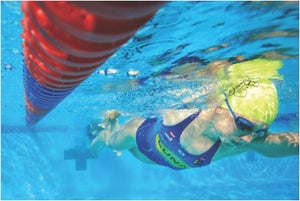New perk! Get after it with local recommendations just for you. Discover nearby events, routes out your door, and hidden gems when you sign up for the Local Running Drop.
Make these drills part of your swim training regimen for improved stroke efficiency.
Written by: Sara McLarty
High-Elbow Catch

The purpose of a drill is to overemphasize a small aspect of the swim stroke to feel the correct position in the water. High-elbow drills help you feel—and make the most of—the power created by keeping your elbow high during the underwater catch phase of your stroke.
Fist Drill is the simplest (and cheapest) drill. Slowly swim freestyle with your hands balled up into fists. Don’t rush the stroke or windmill your arms. Feel the water on your forearms and use them as powerful paddles to move yourself through the water. Tennis balls prevent cheating; you cannot create any water pressure on your hands when you are holding one tennis ball in each. Keep your knuckles pointing toward the bottom of the pool.
Hand paddles can be modified to help strengthen your high-elbow catch. Instead of putting your fingers through the straps, grasp the edge of the paddle so it is lying flat against your wrist. If you bend your wrist, the edge of the paddle should dig into your forearm. Try the Finis Fulcrum paddles, which look like the number “8.” They slide over your fingers and onto your forearm. If you relax your wrist or fingers anytime during freestyle, the paddles will fall off.
Underwater Freestyle Catch
Developing a good underwater freestyle catch is important because it is one of the most crucial elements to forward propulsion. The catch phase of freestyle is performed incorrectly by a majority of novice swimmers. The entire process happens beneath the swimmer’s body, making it hard to observe and mimic.
When your arm is fully extended in the water, the first movement of the catch is to point your fingers to the bottom of the pool. Keep your wrist straight and your elbow bent above your forearm. This arm position forms a strong paddle with a lot of surface area to “catch” the water. Two things to avoid during the freestyle catch: fully straightened arms and crossing the center line of the body.
Take a look at your arm position when you lift yourself out of the pool or push away from your desk. Notice how you achieve the most power by spacing your hands just outside your body, keeping your wrists straight and strong, and bending your elbows near 90 degrees. Feel how your pectoral, tricep and forearm muscles are engaged and strong. Now, take that same position to the pool and feel the power in your underwater catch.